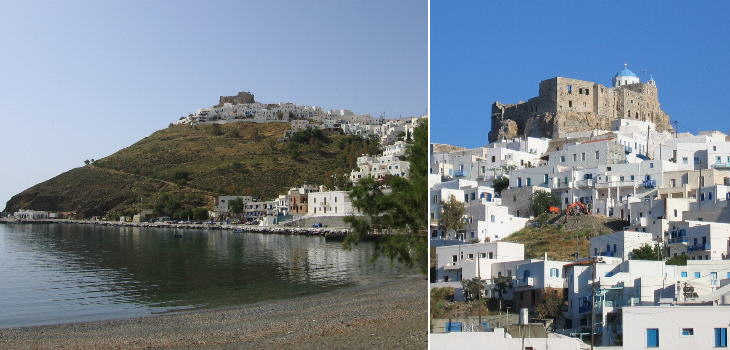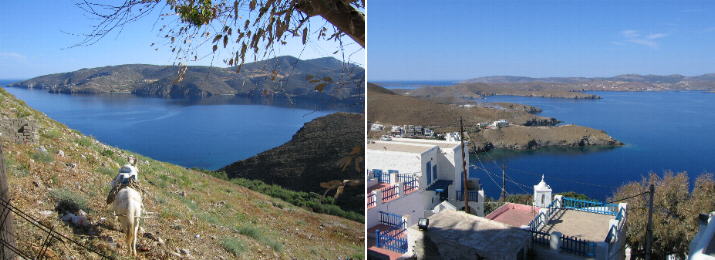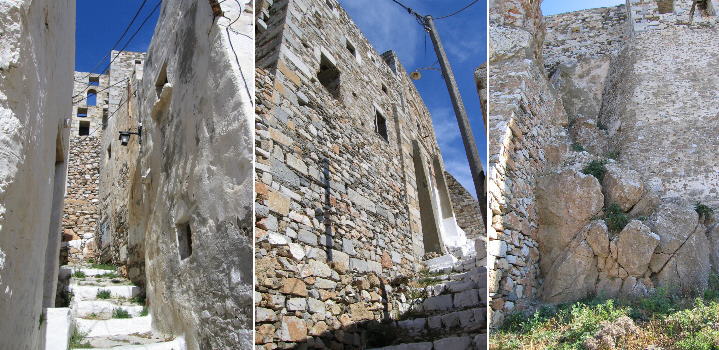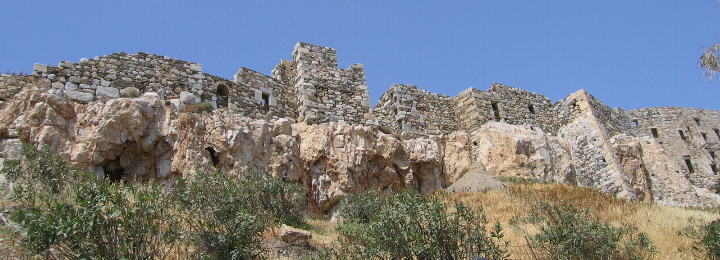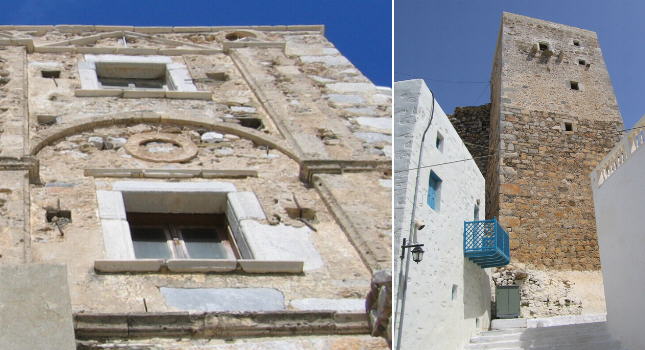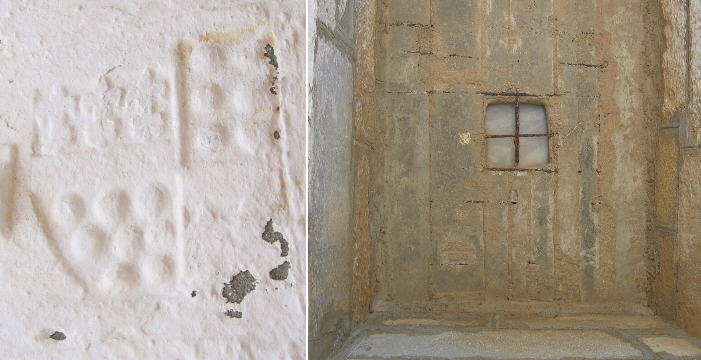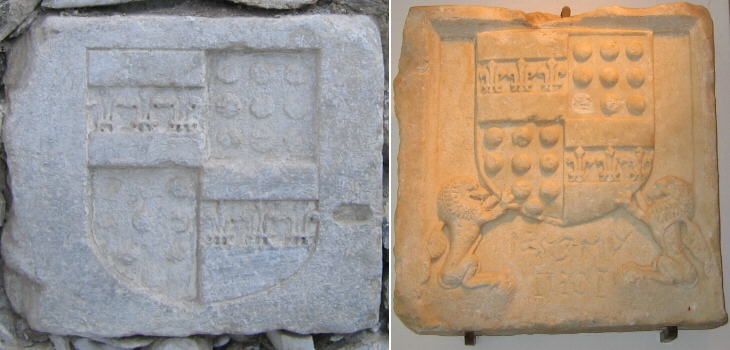  What's New! Detailed Sitemap All images © by Roberto Piperno, owner of the domain. Write to romapip@quipo.it. Text edited by Rosamie Moore. Page added in June 2005. |
 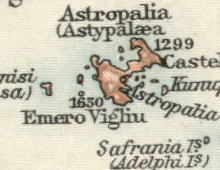 Stampalia (Astipaleia) Stampalia (Astipaleia)
Key dates: 1207 Stampalia is acquired by the Querini, a major Venetian family: the branch ruling on the island became known as Querini Stampalia 1522 Sultan Suleiman I, the Magnificent conquers Rhodes, in the next years he acquires also Stampalia. 1646-68 During the war of Candia, Stampalia falls again under the Venetian influence. Stampalia is part of Dodecanissa (twelve islands) a Greek province in the south eastern part of the Aegean Sea. However the name given to these islands is rather recent as it dates back to 1912 when the Italians occupied them (the largest one being Rhodes); at that time they were still part of the Ottoman Empire and were called Southern Sporades. Stampalia however, because of both its location and history can be more correctly considered as part of the Cyclades.
The acquisition of Stampalia by the Querini follows that of Nasso by Marco Sanudo. But while Nasso was a relatively large island with some fertile valleys and it was surrounded by many other islands, the rugged mountains of Stampalia had very little to offer. If Stampalia had little to attract settlers, it had a lot to attract pirates (and later on corsairs). Its elongated shape and the surrounding islets offered many coves where the pirates could easily hide. A location not far from the main town is still called Maltesana, because the Knights of Malta used to cast anchor there during their raids against the Ottomans.
The main town of Stampalia is located on the top of a hill allowing a view over two small coves and over the narrow isthmus (less than 50 yards) which links the two parts of the island. The Querini built on its top a fortified citadel which included a church and their own palace.
The access to the citadel was protected by the peasants' houses and it could only be reached via a maze of narrow streets. In the XIVth century the rule of the Querini was challenged by the Byzantines and by the Ottomans who were able to seize the island, but the Querini always managed to come back.
The citadel was built on an existing rock and at some points its walls are just a modest addition to the natural precipitous slope. The interior of the citadel is almost completely lost, only the outer walls have survived to this day.
The Querini residence shows some signs of its Renaissance design. In 1413 the Querini made a major attempt to repopulate the island, but with the fall of Constantinople in 1453 and the loss by the Venetians of Negroponte in 1470 the risk of Turkish raids increased.
The situation worsened in 1522 when Sultan Suleyman the Great conquered Rhodes: the fortifications of Stampalia could do very little in case of a serious Ottoman attempt to seize the town: the opening in the ceiling above the entrance was a sort of silver bullet in case of attack: it is said that the defendants used it to throw beehives on the enemy relying on the insects to disband the assailants. Clearly it was a useless weapon against the Sultan's powerful cannon, so the Querini had to resort to diplomacy to avoid losing Stampalia.
A new war between the Ottoman Empire and Venice erupted in 1537: Suleyman wanted to get rid of the Venetian presence in the Levant; rather than fighting in the Aegean Sea, Suleyman moved his army by land to the Albanian shore and from there he laid siege to Corf¨, the key bastion of the Venetian military power in the Mediterranean. Corf¨ did not fall and eventually Suleyman gave up. The Venetians however were willing to reach a peace agreement and in this context in 1540 the Querini had to give Stampalia to the Ottomans. Giovanni Querini Stampalia in 1869 left to the City of Venice all his possessions, which today are managed by Fondazione Querini Stampalia. Introductory page on the Venetian Fortresses Pages of this section: On the Ionian Islands: Corf¨ (Kerkyra) Paxo (Paxi) Santa Maura (Lefkadas) Cefalonia (Kephallonia) Asso (Assos) Itaca (Ithaki) Zante (Zachintos) Cerigo (Kythera) On the mainland: Butrinto (Butrint) Parga Preveza and Azio (Aktion) Vonizza (Vonitsa) Lepanto (Nafpaktos) Atene (Athens) On Morea: Castel di Morea (Rio), Castel di Rumelia (Antirio) and Patrasso (Patra) Castel Tornese (Hlemoutsi) and Glarenza Navarino (Pilo) and Calamata Modon (Methoni) Corone (Koroni) Braccio di Maina, Zarnata, PassavÓ and ChielefÓ MistrÓ Corinto (Korinthos) Argo (Argos) Napoli di Romania (Nafplio) Malvasia (Monemvassia) On the Aegean Sea: Negroponte (Chalki) Castelrosso (Karistos) Oreo Lemno (Limnos) Schiatto (Skiathos) Scopello (Skopelos) Alonisso Schiro (Skyros) Andro (Andros) Tino (Tinos) Micono (Mykonos) Siro (Syros) Egina (Aegina) Spezzia (Spetse) Paris (Paros) Antiparis (Andiparos) Nasso (Naxos) Serifo (Serifos) Sifno (Syphnos) Milo (Milos) Argentiera (Kimolos) Santorino (Thira) Folegandro (Folegandros) Stampalia (Astipalea) Candia (Kriti) You may refresh your knowledge of the history of Venice in the Levant by reading an abstract from the History of Venice by Thomas Salmon, published in 1754. The Italian text is accompanied by an English summary. Clickable Map of the Ionian and Aegean Seas with links to the Venetian fortresses and to other locations (opens in a separate window) |
